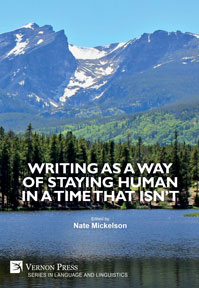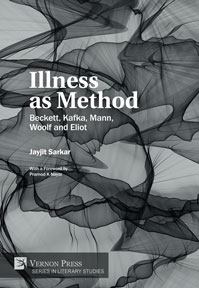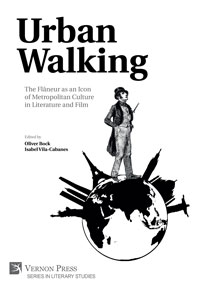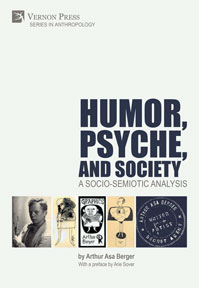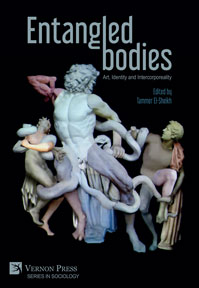The Portrait of an Artist as a Pathographer: On Writing Illnesses and Illnesses in Writing
Jayjit Sarkar, Jagannath Basu (Eds.)
by Tatiana Prorokova (University of Vienna, Austria), Ayub Sheik (University of KwaZulu-Natal, South Africa), Seunghyun Shin (University of Vermont, USA), Nadia Boudidah Falfoul (University of Kairouan, Tunisia), Gabriel Quigley (New York University, USA), Amy W S Lee (Hong Kong Baptist University, Hong Kong), Jamil Ahmed (Middlesex University, UK), Anda Pleniceanu (Western University in Ontario, Canada), Chloe Leung (University of Edinburgh, UK), Nina Muždeka (University of Novi Sad, Serbia), Mohona Banerjee (Amity University, Noida, India), Victoria Lupascu (University of Montréal, Canada), Nhlanhla Landa (University of Fort Hare, South Africa), Sindiso Zhou (University of Fort Hare, South Africa), Edward Grimble (Lancing College, UK), Ronja Tripp-Bodola (Louisiana State University, USA), Anik Sarkar (Salesian College, India), Ricardo Rato Rodrigues (Uniwersytet Marii Curie-Skłodowskiej w Lublinie, Poland), Meltem Gürle (University of Cologne, Germany)
Purchase this book
(click here to change currency)
A vital new collection of essays, The Portrait of an Artist as a Pathographer investigates how literature represents and also shapes the experiences of illness, pain, sensation, and suffering. Drawing on scholars from across the globe, the collection moves deftly among periods, texts, perspectives, and locations to offer a capacious critical mapping of literary pathography.
Elizabeth Outka, University of Richmond
Author of Viral Modernism: The Influenza Pandemic and Interwar Literature (Columbia UP, 2019)
The volume of essays offers a broad literary landscape to get to the heart of the difference between illness and disease. The essays cover an interesting range of writers and genres from around the world to explore the poetics and ethics of illness. Novels, short stories, plays, poems, both canonical and non-canonical, allow the volume to encompass an interesting corpus that will help provide an engaging and timely intervention in the growing field of literature and medicine.
Prof. Sangeeta Ray
University of Maryland
Registering illness as a critical factor that shapes human society— not just as a technocratic or medical issue, but as one that also merits literary and cultural investigation, this compelling and cogently argued volume succeeds in bringing together different encounters between illness and literature across time and space. It is a timely contribution that will be of great interest to scholars in humanities across the globe.
Prof. Priya Menon
Troy University
Focusing on the various intersections between illness and literature across time and space, The Portrait of an Artist as a Pathographer seeks to understand how ontological, phenomenological and epistemological experiences of illness have been dealt with and represented in literary writings and literary studies. In this volume, scholars from across the world have come together to understand how the pathological condition of being ill (the sufferers), as well as the pathologists dealing with the ill (the healers and caregivers), have shaped literary works.
The language of medical science, with its jargon, and the language of the every day, with its emphasis on utility, prove equally insufficient and futile in capturing the pain and suffering of illness. It is this insufficiency and futility that makes us turn towards the canonical works of Joseph Conrad, Samuel Beckett, William Carlos Williams, Virginia Woolf, Kazuo Ishiguro, Miroslav Holub as well as the non-canonical António Lobo Antunes, Yumemakura Baku, Wopko Jensma and Vaslav Nijinsky. This volume helps in understanding and capturing the metalanguage of illness while presenting us with the tradition of ‘writing pain’. In an effort to expand the definition of pathography to include those who are on the other side of pain, the essays in this collection aim to portray the above-mentioned pathographers as artists, turning the anxiety and suffering of illness into an art form. Looking deeply into such creative aspects of illness, this book also seeks to evoke the possibility of pathography as world literature.
This book will be of particular interest to undergraduate, postgraduate and research students, as well as scholars of literature and medical humanities who are interested in the intersections between literary studies and medical science.
Preface
Introduction
I. European Literary Pathographies
Chapter 1 The Gift of Chains: Atopic Violence and Embodied Community in Aeschylus’s Prometheus Bound
Anda Pleniceanu
Western University in Ontario, Canada
Chapter 2 Pathography of Man and Evil in Joseph Conrad’s Heart of Darkness
Nina Muždeka
University of Novi Sad, Serbia
Chapter 3 Care, Pig!: The Abject Caregiver in Beckett’s Plays
Gabriel Quigley
New York University, USA
Chapter 4 “But of course Rachel’s illness is quite different”: Reconfiguring the ‘Medical’ and ‘Illness’ in Virginia Woolf’s The Voyage Out
Chloe Leung
University of Edinburgh, UK
Chapter 5 “Between Horror and Hunger”: Reflections on the Medical Poems of Miroslav Holub
Anik Sarkar
Salesian College, India
Chapter 6 “I am God in a body”: The Diary of Vaslav Nijinsky as Initiation into Psychosis
Jamil Ahmed
Middlesex University, UK
Chapter 7 Doctor, Soldier, Writer: António Lobo Antunes as Portugal’s Pathographer
Ricardo Rato Rodrigues
Jagiellonian University, Poland
II. American Literary Pathographies
Chapter 8 “To Him Who Wants It!”: Understanding William Carlos Williams’ Pathography
Seunghyun Shin
University of Vermont, USA
Chapter 9 Lesbianism, Disability, and Pain: Shirley Jackson’s We Have Always Lived in the Castle as a Pathography
Tatiana Prorokova-Konrad
University of Vienna, Austria
Chapter 10 “The struggle to Breathe”: Narrating the Sick Body in Lorrie Moore’s Short Stories
Nadia Boudidah Falfoul
University of Kairouan, Tunisia
Chapter 11 Taking Turns in Writing Pain: Comics’ Approximation of Pathography
Victoria Lupascu
University of Montréal, Canada
III. Literary Pathographies of the World
Chapter 12 Wopko Jensma as a Pathographer: The Interface between Poetry and Schizophrenia
Ayub Sheik
University of KwaZulu-Natal, South Africa
Chapter 13 The Black Book as Pathography: Romancing Disease and Decay in the Late Ottoman Empire
Meltem Gürle
University of Cologne, Germany
Chapter 14 Dis-eases of the Heart Cured by Magic: Heian Onmyōji in Yumemakura Baku’s Popular Japanese Fiction
Amy W. S. Lee
Hong Kong Baptist University, Hong Kong
Chapter 15 Writing Illness: Morbid Humour as a Strategy to Cope with Disease and Pain in Zimbabwean Literature
Nhlanhla Landa, Sindiso Zhou
University of Fort Hare, South Africa
Chapter 16 “Back from the Shades of Death”: The Pleasures and Pains of Convalescence in the Nineteenth-Century City
Edward Grimble
Lancing College, UK
Chapter 17 The Lessons (Not) Learned: Literary Bioethics and Biopolitics from Stoker to Atwood
Ronja Tripp-Bodola
Louisiana State University, USA
Coda “How is the pain?”
Mohona Banerjee
Amity University, Noida, India
Notes on Contributors
Index
Jayjit Sarkar is Assistant Professor in the Department of English, Raiganj University, India. He is the author of the book 'Illness as Method: Beckett, Kafka, Mann, Woolf and Eliot' (Vernon Press, 2019). He is also the co-editor of 'Border and Bordering: Poetics, Politics, Precariousness' (ibidem Press, 2020).
Jagannath Basu is Assistant Professor in the Department of English, Sitalkuchi College, India. He is the co-editor of 'Geographia Literaria: Studies in Earth, Ethics and Literature' (ibidem Press, forthcoming, 2021).
Literary Theory and Criticism, Medical Humanities, Bioethics, Pathography
See also
Bibliographic Information
Book Title
The Portrait of an Artist as a Pathographer: On Writing Illnesses and Illnesses in Writing
ISBN
978-1-64889-369-8
Edition
1st
Number of pages
323
Physical size
236mm x 160mm

![The Portrait of an Artist as a Pathographer: On Writing Illnesses and Illnesses in Writing [Paperback]](/file/16033/24aa314afdfab9d11a22f4beafd0db83/1638528351.jpg)


